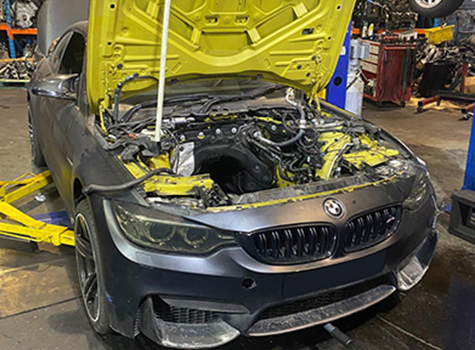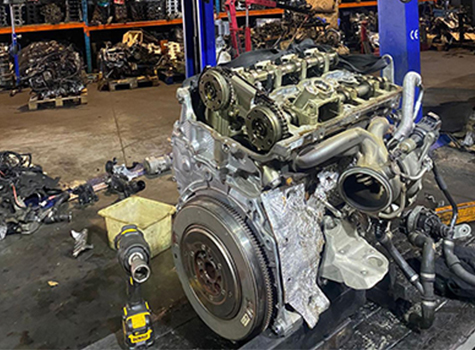The Process and Quality Standards of BMW Reconditioned Engine Rebuilding
BMW Reconditioned Engine Rebuilding Process: Excellence in Restoration
Reconditioning BMW engines is an intricate process that merges technical precision with meticulous quality standards. In this comprehensive guide, we delve into the multifaceted journey of BMW reconditioned engine restoration. We’ll explore each step, from inspection to the final touches, ensuring adherence to the high standards BMW is renowned for. This journey not only revives engines but also reinstates the BMW’s legendary performance and reliability.
The art of BMW engine rebuilding is a testament to engineering excellence. It involves a series of well-defined steps, each crucial to achieving a product that meets and often exceeds the original specifications. In this post, we will navigate through these stages, illuminating the meticulous care and expertise involved in BMW engine rebuilding.
The Process

Reconditioning a BMW engine is a detailed process that starts with a thorough assessment. This phase determines the extent of wear and identifies components needing replacement or repair. It sets the stage for a systematic rebuild, ensuring that every part meets BMW’s stringent standards.
Inspection and Disassembly
The first step in the journey of rejuvenating a BMW reconditioned engine is inspection and disassembly. Skilled technicians meticulously dismantle the engine, cataloguing each component. This process is crucial for identifying wear and potential issues. It’s a blend of expertise and precision, ensuring that every part is evaluated for its integrity and performance potential.
Continuing with the disassembly, each component undergoes a rigorous inspection. Parts are scrutinized for signs of wear, damage, or fatigue. This stage is critical in mapping out a rebuilding strategy, focusing on restoring the engine’s integrity and performance. The goal is to revive the engine to its original state, ensuring it delivers the unmatched performance expected of a BMW.
Cleaning and Evaluation
Cleaning is the next pivotal step in the BMW reconditioned engine process. Using advanced techniques, each component is thoroughly cleaned, removing contaminants that could hinder performance. This is more than just a cosmetic step; it’s about preparing the engine for a successful rebuild.
Following cleaning, a comprehensive evaluation is undertaken. Each part is examined against BMW’s exacting standards. This evaluation is not just about functionality, but also about ensuring longevity and reliability. It’s a testament to BMW’s commitment to excellence, ensuring that every reconditioned engine performs like new.
Machining and Repair
Machining and repair are where the true transformation occurs. Worn components are skillfully machined or replaced to meet BMW’s stringent specifications. This phase is about precision, ensuring that every part fits and functions flawlessly.
The repair process also includes addressing any flaws or damage. Using state-of-the-art equipment and techniques, technicians restore each component’s integrity. This meticulous attention to detail ensures that the reconditioned BMW engine not only runs but excels in performance.
Reassembly and Testing
Reassembling the BMW engine is a task of precision and expertise. Each component is meticulously put back in place, ensuring perfect alignment and functionality. This stage is crucial for the engine’s overall performance, as it brings together all the restored parts into a cohesive, finely-tuned machine.
Testing is the final, yet most critical step in BMW engine rebuilding. The engine is rigorously tested under various conditions to ensure it meets the high standards set by BMW. This includes performance, efficiency, and reliability tests, simulating real-world conditions to guarantee that the engine delivers optimal performance. It’s a rigorous process that leaves no stone unturned, ensuring the reconditioned engine is not just rebuilt, but reborn.
Painting and Final Touches
Once reassembled and tested, the BMW reconditioned engine undergoes painting and final touches. This is more than just an aesthetic step; it’s about protecting the engine and ensuring its longevity. The painting process involves applying high-quality coatings that shield against corrosion and wear, preserving the engine’s pristine condition.
The final touches are about perfection. Every detail is checked and rechecked, from the tightening of bolts to the calibration of components. This meticulous attention ensures that the reconditioned BMW engine not only looks new but also performs with the excellence synonymous with the BMW brand.
Quality Standards

BMW’s commitment to quality is evident in every reconditioned engine. The process adheres to strict quality standards, ensuring that each engine delivers the same performance and reliability as a new one. This commitment to excellence is what sets BMW apart, ensuring customer satisfaction and trust in the brand.
Genuine BMW Parts
The use of genuine BMW parts is central to maintaining the quality and integrity of the reconditioned engines. These parts are designed and manufactured to meet BMW’s exact specifications, ensuring perfect fit and optimal performance. This commitment to using only genuine parts guarantees that each reconditioned engine maintains the brand’s high standards.
BMW-Trained Technicians
The expertise of BMW-trained technicians is a critical component of the reconditioning process. These professionals possess in-depth knowledge and experience with BMW engines, ensuring that every rebuild meets the company’s rigorous standards. Their expertise guarantees that the reconditioned engines are not just rebuilt, but revitalized.
Quality Control
Quality control is an integral part of the reconditioning process. Each stage, from disassembly to final touches, undergoes strict quality checks. This ensures that every reconditioned BMW engine is free from defects and meets the highest standards of performance and reliability.
Warranty
A warranty on reconditioned BMW engines demonstrates confidence in the quality of the rebuild. It offers peace of mind to customers, assuring them of the engine’s reliability and the brand’s commitment to excellence.
Things to Consider
- Engine Source: Reconditioned engines can come from various sources, including salvaged vehicles, core programs, or specialized rebuilders. Research the provider’s reputation and experience before making a decision.
- Cost vs. New Engine: While cheaper than a brand-new engine, reconditioned engines still represent a significant investment. Weigh the cost against the value of your car and potential future repairs.
- Performance Expectations: A reconditioned engine should perform like a well-maintained used engine. Don’t expect the same level of power and efficiency as a brand-new unit.
Final Thoughts
In conclusion, the process of BMW’s reconditioned engine rebuilding is a blend of art and science. It is a meticulous journey that transforms worn engines into powerhouses of performance and reliability. Each step, governed by strict quality standards and executed by skilled professionals, ensures that the reconditioned engine upholds the legacy of the BMW brand.
This process not only extends the life of the engine but also reinforces the commitment to sustainability and customer satisfaction. It’s a testament to BMW’s dedication to excellence, showcasing their ability to not just build great engines but to breathe new life into them, ensuring they continue to deliver the ultimate driving experience.
